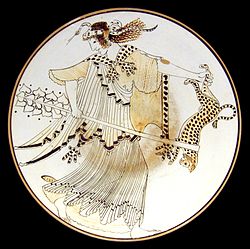
Back Менади Bulgarian Menadezed Breton Menada BS Mènades Catalan Bakchantky Czech Mænade Danish Mänade German Μαινάδες Greek Menado Esperanto Ménades Spanish


In Greek mythology, maenads (/ˈmiːnædz/; Ancient Greek: μαινάδες [maiˈnades]) were the female followers of Dionysus and the most significant members of the thiasus, the god's retinue. Their name, which comes from μαίνομαι (maínomai, “to rave, to be mad; to rage, to be angry”),[1] literally translates as 'raving ones'. Maenads were known as Bassarids, Bacchae /ˈbækiː/, or Bacchantes /ˈbækənts, bəˈkænts, -ˈkɑːnts/ in Roman mythology after the penchant of the equivalent Roman god, Bacchus, to wear a bassaris or fox skin.
Often the maenads were portrayed as inspired by Dionysus into a state of ecstatic frenzy through a combination of dancing and intoxication.[2] During these rites, the maenads would dress in fawn skins and carry a thyrsus, a long stick wrapped in ivy or vine leaves and tipped with a pine cone. They would weave ivy-wreaths around their heads or wear a bull helmet in honor of their god, and often handle or wear snakes.[3]
These women were mythologized as the "mad women" who were nurses of Dionysus in Nysa. Lycurgus "chased the Nurses of the frenzied Dionysus through the holy hills of Nysa, and the sacred implements dropped to the ground from the hands of one and all, as the murderous Lycurgus struck them down with his ox-goad".[4] They went into the mountains at night and practised strange rites.[5]
According to Plutarch's Life of Alexander, maenads were called Mimallones and Klodones in Macedon, epithets derived from the feminine art of spinning wool.[6] Nevertheless, these warlike parthenoi ("virgins") from the hills, associated with a Dionysios pseudanor ("fake male Dionysus"), routed an invading enemy.[7] In southern Greece they were described as Bacchae, Bassarides, Thyiades, Potniades,[8][better source needed] and other epithets.[9]
The term maenad has come to be associated with a wide variety of women, supernatural, mythological, and historical,[10] associated with the god Dionysus and his worship.

In Euripides' play The Bacchae, maenads of Thebes murder King Pentheus after he bans the worship of Dionysus. Dionysus, Pentheus' cousin, himself lures Pentheus to the woods, where the maenads tear him apart. His corpse is mutilated by his own mother, Agave, who tears off his head, believing it to be that of a lion. A group of maenads also kill Orpheus,[11] when he refuses to entertain them while mourning his dead wife.
In ceramic art, the frolicking of Maenads and Dionysus is often a theme depicted on kraters, used to mix water and wine. These scenes show the maenads in their frenzy running in the forests, often tearing to pieces any animal they happen to come across.[citation needed]
German philologist Walter Friedrich Otto writes:
The Bacchae of Euripides gives us the most vital picture of the wonderful circumstance in which, as Plato says in the Ion, the god-intoxicated celebrants draw milk and honey from the streams. They strike rocks with the thyrsus, and water gushes forth. They lower the thyrsus to the earth, and a spring of wine bubbles up. If they want milk, they scratch up the ground with their fingers and draw up the milky fluid. Honey trickles down from the thyrsus made of the wood of the ivy, they gird themselves with snakes and give suck to fawns and wolf cubs as if they were infants at the breast. Fire does not burn them. No weapon of iron can wound them, and the snakes harmlessly lick up the sweat from their heated cheeks. Fierce bulls fall to the ground, victims to numberless, tearing female hands, and sturdy trees are torn up by the roots with their combined efforts.[12]
- ^ Harry Thurston Peck, Harpers Dictionary of Classical Antiquities (1898), Maenades
- ^ Wiles, David (2000). Greek Theater Performance: An Introduction. Cambridge, England: Cambridge University Press.
- ^ Abel, Ernest L. (2006). Intoxication in Mythology: A Worldwide Dictionary of Gods, Rites, Intoxicants, and Place. Jefferson, NC and London: McFarland & Co., Inc.
- ^ Homer, Iliad 6.130 ff., in E.V. Rieu's translation.
- ^ Lever, Katherine (1956). The Art of Greek Comedy.
- ^ According to Grace Harriet Macurdy, "Klodones, Mimallones and Dionysus Pseudanor," The Classical Review 27.6 (September 1913), pp. 191-192, and Troy and Paeonia. With Glimpses of Ancient Balkan History and Religion, 1925, pg. 166.
- ^ According to the second-century CE Macedonian military writer Polyaenus, IV.1; Polyaenus gives a fanciful etymology.
- ^ Potnia means "lady" or "mistress".
- ^ Harrison, Jane Ellen (1922). "The Maenads". Prolegomena to the Study of Greek Religion, 3rd ed. pp. 388-400.
- ^ Jane Ellen Harrison remarked of the 19th-century (male) classicists, "so persistent is the dislike to commonplace fact, that we are repeatedly told that the maenads are purely mythological creations and that the maenad orgies never appear historically in Greece." Prolegomena to the Study of Greek Religion, 3rd ed. (1922). pg. 388
- ^ Apollodorus, 1.3.2. "Orpheus also invented the mysteries of Dionysus, and having been torn in pieces by the maenads he is buried in Pieria."
- ^ Otto, Walter F. (1965). Dionysus: Myth and Cult. Bloomington and Indianapolis: Indiana University Press. pg. 96